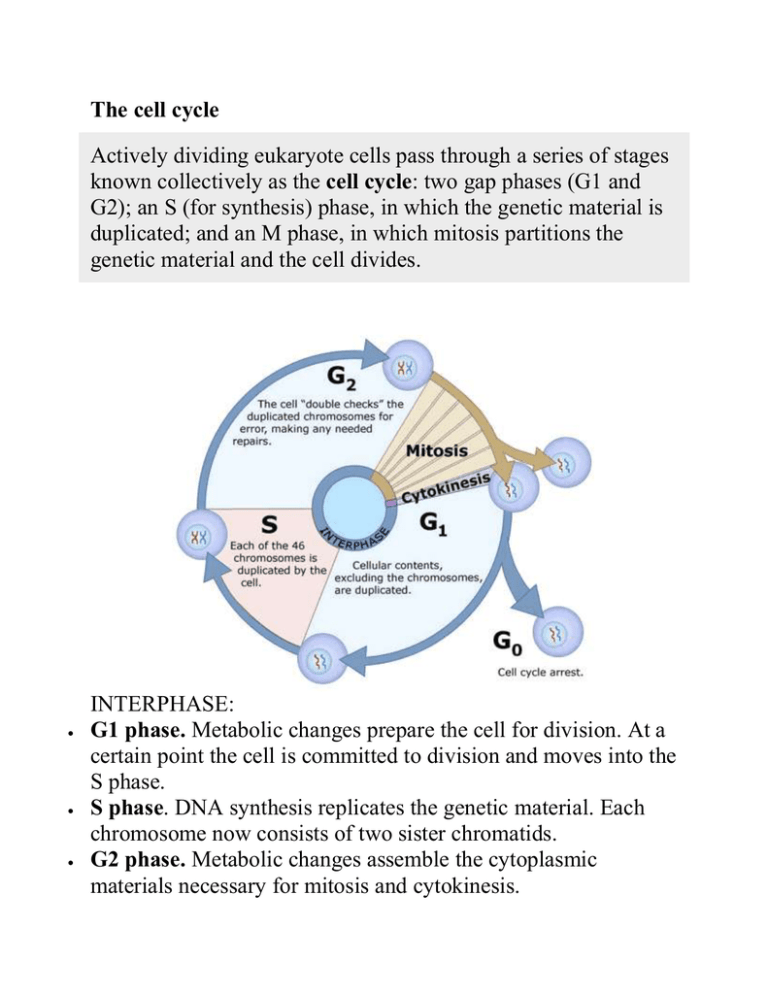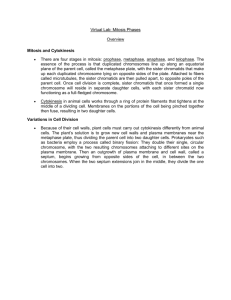The cell cycle Mitosis Note
advertisement

The cell cycle Actively dividing eukaryote cells pass through a series of stages known collectively as the cell cycle: two gap phases (G1 and G2); an S (for synthesis) phase, in which the genetic material is duplicated; and an M phase, in which mitosis partitions the genetic material and the cell divides. INTERPHASE: G1 phase. Metabolic changes prepare the cell for division. At a certain point the cell is committed to division and moves into the S phase. S phase. DNA synthesis replicates the genetic material. Each chromosome now consists of two sister chromatids. G2 phase. Metabolic changes assemble the cytoplasmic materials necessary for mitosis and cytokinesis. M phase. A nuclear division (mitosis) followed by a cell division (cytokinesis). Mitosis Mitosis is a form of eukaryotic cell division that produces two daughter cells with the same genetic component as the parent cell. Chromosomes replicated during the S phase are divided in such a way as to ensure that each daughter cell receives a copy of every chromosome. In actively dividing animal cells, the whole process takes about one hour. The replicated chromosomes are attached to spindle fibres, a 'mitotic apparatus' that aligns them and then separates the sister chromatids to produce an even partitioning of the genetic material. This separation of the genetic material producing two nuclei is followed by a separation of the cell cytoplasm in a cellular division (or cytokinesis) to produce two daughter cells. Mitosis, although a continuous process, is conventionally divided into five stages: prophase, prometaphase, metaphase, anaphase and telophase. The phases of mitosis Prophase Prophase occupies over half of mitosis. The nuclear membrane breaks down to form a number of small vesicles and the nucleolus disintegrates. A structure known as the centrosome duplicates itself to form two daughter centrosomes that migrate to opposite ends of the cell. The centrosomes organise the production of microtubules that form the spindle fibres. The chromosomes condense into compact structures. Each replicated chromosome can now be seen to consist of two identical sister chromatids held together by a structure known as the centromere. Prometaphase The chromosomes migrate to the equatorial plane in the mid-line of the cell. Individual spindle fibres bind to a structure on each side of the centromere. The chromosomes continue to condense. Metaphase The chromosomes align themselves along the metaphase plate of the spindle apparatus. Anaphase This is the shortest stage of mitosis. The centromeres divide, and the sister chromatids of each chromosome are pulled apart and move to the opposite ends of the cell, pulled by spindle fibres. The separated sister chromatids are now referred to as daughter chromosomes. (It is the alignment and separation in metaphase and anaphase that is important in ensuring that each daughter cell receives a copy of every chromosome.) Telophase This is final stage of mitosis, and a reversal of many of the processes observed during prophase. The nuclear membrane reforms around the chromosomes grouped at either pole of the cell, the chromosomes uncoil and become diffuse, and the spindle fibres disappear. Cytokinesis The final cellular division to form two new cells. In plants a cell plate forms along the line of the metaphase plate; in animals there is a constriction of the cytoplasm. The cell then enters interphase - the interval between mitotic divisions. Ref: University of Leicester, VGEC (cell, mitosis).




